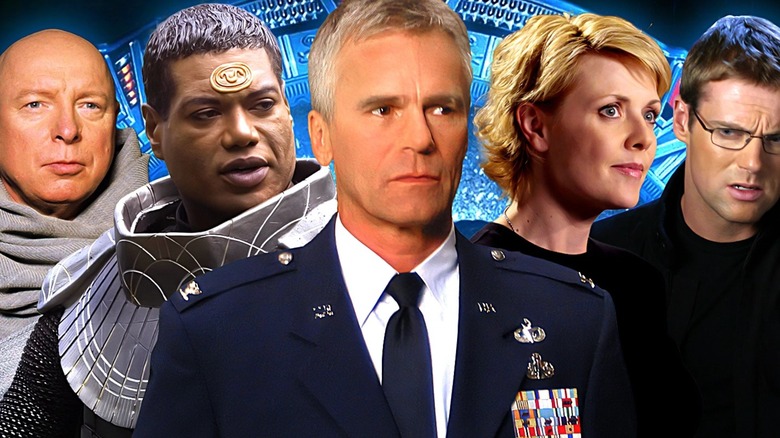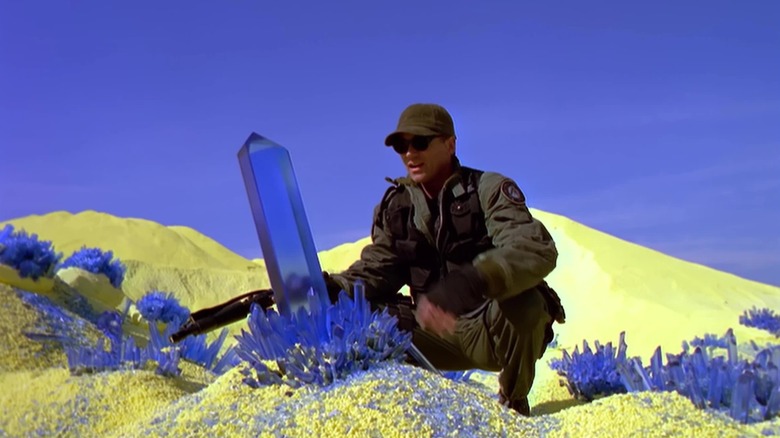Where Was Stargate SG-1 Filmed? Every Major Location, Explained
This post contains spoilers for "Stargate SG-1."
Jonathan Glassner and Brad Wright's "Stargate SG-1" is beloved for a reason. Apart from breathing new life into Roland Emmerich's fun, imperfect 1994 flick "Stargate," the 10-season series evolved it into a prestigious sci-fi franchise with intricate lore. As "SG-1" is a space adventure, it was natural for the series to jump locations quite often, since the titular crew would have to travel to distant planets as a part of their mission to protect Earth. From a logistical standpoint, the series had to be filmed in locations that offered aesthetic variety; unfortunately, a limited budget meant that shooting was narrowed down to two key locations, namely Colorado and Vancouver.
To better understand the decision to shoot in these locations, we need a refresher on the show's premise. Most interior scenes take place inside the Stargate Command, the military base that offers mission-related support to teams, including the SG-1. As the interiors of this base remain uniform throughout the series, it makes sense that they were filmed at The Bridge Studios in Vancouver. After all, indoor sets are much easier to tweak and control, as they do not pose the same risk of unpredictability as exterior locations (in this case, the forests of British Columbia were a challenge to navigate). Also, as the SG-1 crew mostly visited alien planets throughout the series, the same exterior locations had to be dressed up to simulate distinct worlds — a creative endeavor that yielded mixed results as the series progressed.
We also need to keep in mind that "SG-1" was filmed way before the invention of The Volume, which, to simplify it, is wraparound screen technology that provides digital backdrops synced with the camera to offer the illusion of distance and depth. As every block of "SG-1" world-building had to be built with a mix of practical solutions and limited CGI, it became progressively difficult to keep things visually fresh. Let's dig deeper into the Colorado and Vancouver locales used in the series, and why filming proved to be a challenge in general for "Stargate SG-1."
The majority of Stargate SG-1 was shot extensively in Colorado and Vancouver
All exterior shots of the Stargate Command were filmed at the Cheyenne Mountain Air Force Station in Colorado, as the fictional structure is supposed to evoke a sense of military secrecy. The remaining outdoor scenes were predominantly shot in Vancouver, and everything from the Kallana (a planet in the Milky Way) to Apophis Crashes was filmed in that area. For instance, the Former Richmond Sand Dunes served as a valuable location for scenes set in the desert, including the depiction of the Tok'ra Base in season 2 and even 3000 B.C. Giza (yes, "SG-1" dabbles in time travel a lot more than you'd expect) in season 8 of the series.
These vast, empty desert exteriors could be remodeled according to the evolving lore, and anything that looked too similar could be camouflaged with the help of character-centric arcs that pull our attention away from paying too much attention to the environments. Real hospitals and apartment buildings in Vancouver were also used extensively to progress the plot, along with public structures such as the Bloedel Conservatory (featured heavily in the episode, "The Gamekeeper") or the Vancouver Art Gallery (whose exterior shots were used to portray the National Intelligence Department building).
If you've been able to draw visual similarities between two different locations in the series, it's most likely because the same location was revamped to serve as a backdrop on more than one occasion. A good example would be the Accent Inn at Barnaby, which was remodeled various times for different scenes, including the motel hideout in "Affinity," Vala's hotel room in "Memento Mori," and Senator Kinsey's hotel (where he is shot in "Smoke & Mirrors.")
Other notable Vancouver locations include Jericho Beach, Sunset Beach Park, The Palisades West Tower, and the Mountain View Cemetery, which crop up as reused backdrops across the seasons (and are pretty easy to spot if you're familiar with these real-life places).
The SG-1 crew dealt with severe location-related problems across 10 seasons
The use of 3D backdrops to simulate real-world locales will always be fundamentally different from shooting on location. "SG-1" embraced the perks of the latter with great gusto, but sustaining this creative streak became challenging over the course of 10 seasons. The fact that the series usually featured a new location every episode certainly did not help matters, as the scope of the intergalactic world-building demanded new landscapes, structures, and expectations surrounding undiscovered corners of the galaxy.
Lynn Smith and N. John Smith, who oversaw location-related matters during the production of "Stargate SG-1," told GateWorld about the multi-pronged issues that cropped up while filming on location. This included figuring out a way to film night scenes during the day, and ensuring that controlled explosions during filming did not inconvenience residential shoot locations. Lynn Smith explained the nuances of the latter in some detail:
"Much of our show was gunfire and explosions. That was the hard part, because you had to get [the city's] blessing. If we're going to the dunes, that's me talking to the tower at the airport for flight paths. And believe it or not, yes, sometimes they would work in our favor [...] or they would tell us if [we would] run into a problem that day."
At one point, "SG-1" was being filmed at the same time as "Stargate Atlantis," allowing the location crew to make the best use of shared sound stages and indoor sets, which would be efficiently changed up to serve the respective shows. But this also meant constant back-and-forth with two separate writing teams and accommodating any last-minute changes (that are bound to take place in any busy production) while working around the clock. N. John Smith, who also served as executive producer for "SG-1," spoke about the risk of crew burnout in the absence of regular hours:
"The secret to doing a series like that is to keep the hours regular. We would push calls [to a certain hour of the day], but we did a lot of exteriors and interiors. We built sets because what kills a crew is going out in the summer [...] So you'd set your night scene at like 9 o'clock, and work all night. And you do that for a couple of months running, and all of a sudden your crew is worn out, and the work doesn't get done properly, and it shows."
Despite these challenges, which resulted in a decline in quality genre settings over time, "Stargate SG-1" has managed to impress audiences with its exciting storylines. Any glaring flaws can be overlooked, as few long-standing sci-fi shows have been able to accomplish so much with so little.


